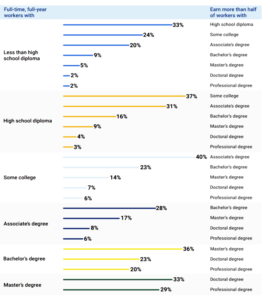A bachelor’s degree is a reliable route to a well-paying job, but it is not the only pathway. In fact, as concerns grow about the affordability of a college degree and the labor market remains tight, middle skills credentials represent good alternatives that often pay off for workers.
Many jobs in today’s economy do not require a bachelor’s degree.
Just under one-third of America’s jobs today require more education than a high school diploma but less than a bachelor’s degree. There are many of these so-called middle skills jobs in the economy, but those that pay well are concentrated in blue-collar, sales, information technology, law enforcement, and healthcare professional and technical occupations. Enrolling in a specialized program at a community college or an apprenticeship program can get many Americans prepared to work in and master the tasks associated with these well-paying middle skills jobs.
Fewer jobs that require no more than a high school diploma are available today than 40 years ago.
Since the 1980s, jobs that require only a high school diploma and no college degree have been on the decline. This trend closely tracks the decline in manufacturing: mechanization and automation prioritized the work and productivity of machines over manpower to perform repetitive and physically-demanding tasks. Coupled with the decline in manufacturing, the rise of the use of computers also meant fewer opportunities for those who lacked computer or other advanced skills. As high school jobs waned, the number of middle skills jobs and jobs that required at least a bachelor’s degree rose to fill the gap. Americans responded by flooding to college campuses – for two- and four-year education and training programs that would enable them to secure good jobs.
As the bachelor’s degree has become less attainable for many, more Americans are considering middle skills jobs.
Many people are now increasingly jaded about the true value of a college degree. Rising tuition and the perception of overqualified workers making poor earnings have left Americans questioning whether college campuses are the best places to go after finishing high school. Others reasons abound for questioning the value of college, all of them related to cost. They include ballooning student loan debt, legal challenges that threaten to strike down the student-loan forgiveness granted by the Biden administration, the failure to implement a national policy of free community college, and strict rules against discharging student loan debt through bankruptcy proceedings.
For some students, non-college options will lead to good jobs. But for low-income Americans, especially those from historically underrepresented groups, questions about whether a bachelor’s degree program pays off are further complicated by inequitable access to college, particularly selective colleges. Simply looking at college completion and graduation rates by gender and race/ethnicity tells us that young men across the board and young Black/African American, Hispanic/Latino, and Native American men and women are being left behind in increasing numbers.
A compounding factor is inequity in college preparedness. Widening gaps in high school graduation rates by race/ethnicity and income point to larger societal and historical inequalities. Lack of college access and preparedness creates additional barriers for historically underrepresented and low-income students already questioning whether college is worth the investment.
Today’s tight job market means middle skills workers can do very well.
A wild card in this discussion is the current job market, which is pretty tight and holding steady, delivering 392,000 jobs per month on average in 2022 despite the ramblings of a pending recession. When jobs are plentiful, tight job markets put more employment options in the hands of workers. College-going loses out to a well-paying job in a simple cost-benefit short-run calculation. Moreover, current and future infrastructure spending promise even more jobs to these workers: about 85 percent of infrastructure jobs will go to workers’ middle skills.
Given this state of affairs, one should not overlook the benefits of pursuing jobs that require training and credentials beyond a high school diploma but short of a bachelor’s degree.
Maryland has dropped the bachelor’s degree requirement for many state jobs.
States like Maryland are leading the way in eliminating the bachelor’s degree requirement for thousands of state jobs. This opens up a pathway for STARs (Skilled through Alternative Routes) job-seekers to get these jobs, earning fairly high wages for the competencies they bring to the table.
Many middle skills can pay more than a bachelor’s degree.
The job market continues to reward workers for higher levels of education, in general, but there are many associate’s degrees that pay more than a bachelor’s degree and many test-based certifications and licenses that pay more than an associates’ degree. Nine percent of workers without a high school diploma, 16 percent of high school graduates, 23 percent of workers with some college education but no degree, and 28 percent of associate’s degree holders earn more than what half of workers with a bachelor’s degree earn.
Figure 1: Nearly one-third of associate’s degree holders can earn more than half of workers with a bachelor’s degree.

The federal government should do more to support middle skills credentialing.
Adequate funding and quality assurance for middle skills programs have long been challenges. Graduates of these programs must be better off financially for having completed them. But the lack of useful information can leave students struggling to decipher which institution to attend and which program to choose. At the same time, programs must be closely aligned with local workforce needs.
While the programs are generally inexpensive by the standards of higher education, they may still be unaffordable to many who would like to enroll. There are many tools in the works to make them more affordable. For one, allowing students to use federal Pell Grants to pay for short-term workforce-training programs could remove archaic rules that limit financial assistance to low-income students. Currently, Pell Grants are available for programs that are at least 15 weeks in length and require at least 600 hours of training. The House passed an amendment earlier this year to expand eligibility for Pell Grants to programs that are between 150 and 600 hours over an 8-to-15-week time frame. Both community colleges and the broader business community generally support these proposals. But the language was never included in another bill, and the chief sponsor of the proposal, Rep. Andy Levin, D-Michigan, lost his primary election and won’t return to Congress in January.
We could also guarantee the quality of these programs by setting regulatory standards, such as requiring that those who finish a program must see a 20 percent boost to their median earnings. That would help weed out bad programs that don’t add value yet hide behind voluminous amounts of disinformation that many students are unable to decipher.
More selective colleges and universities, however, probably don’t want to be subjected to any guidelines that set a standard for the value of college programs. To be blunt, the more opaque the lines connecting programs of study and value are, the less accountable postsecondary institutions have to be for programs that fail students.
But many community colleges would happily subject themselves to these kinds of regulatory regimes if it meant more students and funding. In general, these colleges are convinced of the value of the programs and feel they would easily meet any guidelines requiring higher earnings.
It’s time to shine a light on the value of middle skills qualifications in this changing and highly competitive job market. With increased financial assistance for students and greater transparency and accountability, these programs can better serve students while meeting workforce needs.
______________________________________________________________________________________________________________________
 Nicole Smith
Nicole Smith
Nicole Smith is a Research Professor and Chief Economist at the Georgetown University Center on Education and the Workforce where she leads CEW’s econometric and methodological work. Dr. Smith has developed a framework for restructuring long-term occupational and educational projections. This framework forms the underlying methodology for a report that projects education demand for occupations in the US economy through 2030. She is part of a team of economists working on a project to map, forecast and monitor human capital development and career pathways.






